- District Heating
- Posted
Moate point

A new development in County Westmeath answers a nagging question about district heating: how to make it financially viable when it services energy efficient buildings. Lenny Antonelli visited a housing estate that combines low energy design with an innovative district heating system and ecological timber frame construction
A new housing development in Moate is pushing back the boundaries of district heating. Bacoro Developments’ Oak Hill estate doesn’t just prove that district heating can be economically viable when servicing energy efficient housing, it does so with a remarkably small system: the forty house development is heated by two boilers with a combined output of just 135kW.
Boasting wood pellet district heating, solar thermal panels and timber frame construction, Oak Hill is a low-density development of 40 terraced, semi-detached and detached houses ranging from 1,130 to 1,815 square feet.
Long popular in parts of western Europe, district heating’s advantages have slowly become obvious to Irish developers. As well as saving space in houses, district heating simplifies maintenance by replacing individual boilers with a centralised unit. It offers energy security too: unlike national energy networks that deliver a single fuel (such as gas or electricity) and leave residents exposed to supply threats, district heating pipes hot water from a central boiler, giving users the flexibility to change their fuel (by replacing the boiler or using a multi-fuel boiler) with relative ease, based on fuel price and availability.
A popular way of financing such systems is through an energy service company (ESCo) that bears the capital cost of the system and then charges users for heating and maintenance. However, with the introduction of 40 per cent energy reductions under the new Part L of building regulations in July, developers may have doubted the economic viability of district heating that services houses with reduced fuel demand.
Oak Hill could put those doubts to bed. Running the ESCo himself, Bacoro’s managing director Ronan Meeley has set a flat annual fee of e600 per house for space and water heating, to a maximum of 4,500 kWh. After this, residents are charged 7c per kWh (for comparison, the price of home heating oil is currently around 13c per kWh). By fixing the cost, Meeley has turned the ESCo model on its head: while ESCos typically earn more when householders use extra heat, Meeley will earn more when they use less, providing an incentive for developers and other ESCo operators to reduce energy demand in their buildings.
How did Meeley set his price? “The site is split into three phases. After the first phase of 19 houses was done, we hooked up an oil boiler to the district heating system and provided heat for free from September to Christmas (2007). That’s how we knew how much heat the houses needed,” he says. By initially providing free heating and encouraging householders to use it liberally, he ensured demand wouldn’t be underestimated.
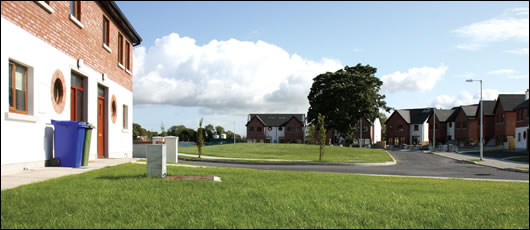
Oak Hill is a low-density development of 40 terraced, semi-detached and detached timber frame houses
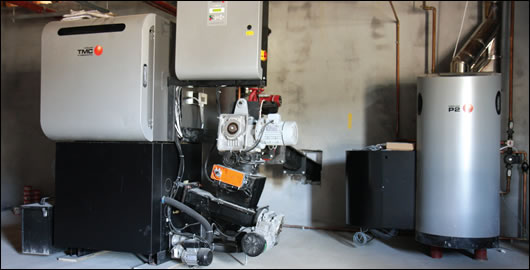
Two Froling wood pellet boilers heat the development: one is a 110kW unit, the other 25kW. The 25kW unit supports the base load and is constantly switched on, thus avoiding the inefficiencies that occur when boilers power up or down
The ESCo isn’t the only innovative aspect of Oak Hill. Installing an oil boiler first and monitoring demand meant Meeley could avoid over-sizing the wood pellet system that followed, comprised of two Froling boilers: one 110kW unit, and one 25kW. The latter boiler is on constantly, eliminating the efficiency losses that occur when boilers power up or down. The 110kW boiler kicks into action when needed. “If the water temperature drops by 5oc, the 110kw boilers turns on,” Meeley says.
The system is impressively small for district heating. Bacoro’s previous development in Ballymahon, Co Longford featured 36 houses, each heated by a 15kW modulating pellet boiler - a combined output of 540kW for 36 houses. “The proof of the pudding is in the fact that a 25kW boiler supports a base load [for the 40 houses],” Meeley says. By ensuring this fit, he has saved in both the cost and embodied energy of the system, and has avoided the inefficiencies associated with oversized boilers.
Meeley intends to build 26 more houses in phase three of the development, bringing the total to 66. Francis Martin of Powertech, who supplied the boilers, doesn’t think this will necessitate extra boiler capacity: “I believe [the current system] will do the 66 houses, but if not we can stick in another 25kW boiler. They’re more efficient when they’re staggered anyway.”
Interestingly, Meeley originally intended to install individual pellet boilers at Oak Hill. A phone conversation with Construct Ireland changed his mind. “Jeff Colley (Construct Ireland) editor suggested I think about district heating. I did know about it, but I suppose he gave me the push to check it out.” Why did he choose wood pellets? “Wood chips have too high a moisture content for me personally,” he says.
Inside the houses, the heating system is divided into three zones: upstairs, downstairs and hot water, with the temperature in each controlled by a simple daisy wheel. Meeley says that, in his experience, people can be uncomfortable with digital controls.
Galway based energy consultancy Energy Matters performed BER assessments for two houses on site - both were given B1 ratings. A semi-detached house achieved 89kWh/m2/yr, while a detached house received 91.01kWh/m2/yr. Energy Matters provide a broad range of energy-efficiency design, testing and certification services.
Managing director Ronan Rogers posits that BERs may not accurately reflect the benefits of district heating. He estimates the annual space and water heating costs for a detached house at Oak Hill, based on the delivered energy calculated in DEAP (the software used to calculate BERs), to be e758 - well above the e600 figure Meeley is charging. Rogers considers this anecdotal evidence that DEAP is overestimating the delivered energy. Meeley concurs. “That’s certainly the case. I have a year of stats to prove it,” he says.
Any discrepancy between calculated and actual delivered energy could result from the 110kW boiler and associated system performing better than the 81.4 per cent seasonal efficiency calculated in DEAP. One way of understanding this, Rogers says, is that DEAP allocates the inefficiency of the main boiler, in this case 15.9 per cent, to every house, rather than dividing it over all 40. “That’s a somewhat simplified description. There’s some benefit in DEAP to the fact that one boiler is divided over all the houses, but it’s a good way of looking at it.” Meeley says this is his main complaint with how DEAP handles district heating. Rogers says that getting the boiler’s efficiency certification recognised by SEI for inclusion in DEAP was a protracted task that involved obtaining certification for both the efficiency testing procedure and the test house used, and then getting the certs recognised by SEI. The task was made more difficult by the fact that much of the relevant documentation was in German.
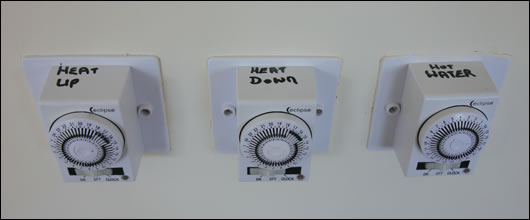
Heating is divided into three zones: upstairs, downstairs and hot water, with each controlled by a simple daisy wheel. Meeley says that in his experience, people can be uncomfortable with digital heating controls
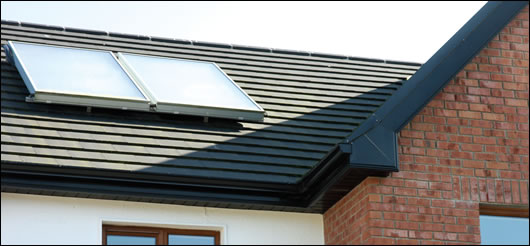
Each house at Oak Hill boasts 4.68m2 of Wikora-manufactured Absol flat plate solar panels, supplied by Heat Merchants
Large boilers, such as those used for district heating, are typically less efficient than those designed for individual households. Rogers re-ran the DEAP analysis for the detached house, replacing district heating with individual 97 per cent efficient oil boilers for the purpose of the calculation. This produced a BER of 91.89kWh/m2/yr, suggesting DEAP offers little advantage to biomass district heating. Rogers believes developers will be less enthusiastic about adopting district heating until BERs more accurately reflects its benefits. District heating does help the detached house’s carbon dioxide energy rating (CDER) though: it rises from 4.74 kg/m2/yr to 24.01 kg/m2/yr when district heating is replaced by oil boilers in DEAP. The effect of this is limited; although a CDER scale is included on each BER cert alongside the BER scale, CDER differs in that the numbers are not converted into a band of letters, such as the A-G BER scale. Without such a reference point, it’s arguable that the carbon dioxide emissions rating will have little effect on buyers. After all, how many consumers would know how to make sense of a figure expressed as kg/m2/yr?
Each roof at Oak Hill supports 4.68 m2 square metres of Wikora manufactured Absol flat plate solar panels, connected to 300 litre two-coil stainless steel cylinders. The panels, supplied by Heat Merchants, face in directions varying between south and south-west. “Over the course of the year they can provide up to 70 per cent of a house’s hot water needs,” says Donal Mannion of Heat Merchants.
The district heating system boasts another unique feature: it has no buffer tank, with hot water instead circulating constantly in a network of highly insulated pipework. “The piping acts as a buffer. There’s an 8,000 litre capacity in the system, and the water is kept hot all the time,” Meeley says.
Powertech supplied the two Froling boilers, and managing director Francis Martin says the absence of a buffer tank makes sense. “When you have 66 houses there’s always going to be a demand for hot water, so that means you’ve always got an outlet away from the boiler. That does the same thing as your buffer tank,” he says.
Modern Timber Homes supplied the timber frame system. The timber is first treated to ensure durability, and the factory built frames are assembled on site. Rather than boring the frame, services are installed after cross battening, and a breather membrane is attached to outer walls. 150mm of Warmcel 500 insulation – supplied by the Gilmartin Group – was pumped into the walls, giving them a u-value of 0.26w/m2K. Warmcel is essentially recycled newspaper, with boric acid added to act as a flame retardant.
Paul Gilmartin of the Gilmartin Group said in the January 2007 issue of Construct Ireland about the product: “A lot of the recycled paper is sourced here in Ireland and shipped over to Wales. They make it into insulation and we take it back.”
The attics at Oak Hill boast 300mm of Warmcel 300 (delivering a u-value of 0.26w/m2K) as well as 100ml of Kingspan on the slope section (u-value of 0.23w/m2K). Windows throughout the houses, supplied by Munster Joinery, are double glazed with 16mm of argon fill, at a u-value of 1.5w/m2K for the glass and 1.9w/m2/K for the full unit. The houses tested by Energy Matters achieved air-tightness results of 3.86m3/hr/m2 and 3.7m3/hr/m2.
Meeley is charging an average of e230,000 for the houses - the same as conventional developments nearby. He’s not including the capital cost of district heating in the price. “I’ve adopted the cost of the district heating, and I’m getting it back on the heat meter,” he says.
Of the 40 houses completed last year, 38 have been sold: a remarkable feat given the current economic climate, and further anecdotal evidence that low energy housing is performing ahead of the market. “The banks couldn’t believe they’d all sold,” says Meeley, who thinks financial institutions are becoming more aware of the importance of energy performance in buildings. He says that conventional housing in the area is struggling to sell, and his confidence in green building is exemplified by his intention to construct 26 more houses at Oak Hill. “The district heating system is in place, and if I don’t build them now I’ll lose out on the potential to earn from it,” he says.
Clearly Meeley subscribes to the idea that energy efficient housing can continue to sell – a notion the broader construction industry is slowly picking up on. And with Oak Hill boasting such an innovative ESCo and district heating system, Meeley shouldn’t be surprised if energy efficiency isn’t the only aspect of Oak Hill that’s soon copied.
Selected project details
Developer: Bacoro Developments
Timber frame: Modern Timber Homes
Cellulose insulation: Gilmartin Group
Biomass boilers: Powertech
Solar thermal systems: Heat Merchants
BER & air–tightness testing: Energy Matters
- Articles
- district heating
- Moate point
- timber frame
- energy efficient
- low energy design
- cellulose
- biomass
Related items
-
 Up to 11
Up to 11 -
 It's a lovely house to live in now
It's a lovely house to live in now -
 HomeWorld 1981: car engine-driven houses & low energy ideas that stuck
HomeWorld 1981: car engine-driven houses & low energy ideas that stuck -
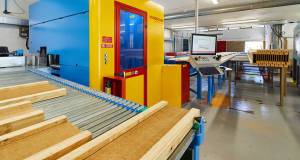 We Build Eco flat pack timber frame partnership gathers pace
We Build Eco flat pack timber frame partnership gathers pace -
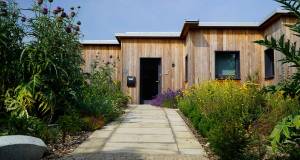 Mass timber masterwork
Mass timber masterwork -
 AECB conference to showcase timber innovation
AECB conference to showcase timber innovation -
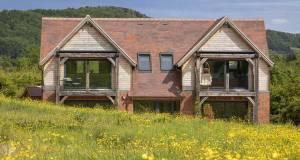 Heart of oak
Heart of oak -
 Ecocel supplying English developer Bell Blue
Ecocel supplying English developer Bell Blue -
 Welsh social housing to embrace passive house, timber & life cycle assessment
Welsh social housing to embrace passive house, timber & life cycle assessment -
 Cambridge chooses passive house comfort for Kings’ College students
Cambridge chooses passive house comfort for Kings’ College students -
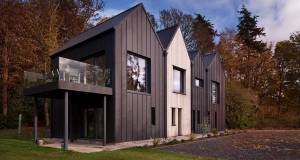 Pitch perfect - Beguiling Dundee passive house puts wood into woodland
Pitch perfect - Beguiling Dundee passive house puts wood into woodland -
 Above the curve - Limerick passive house showcases precision timber engineering
Above the curve - Limerick passive house showcases precision timber engineering

